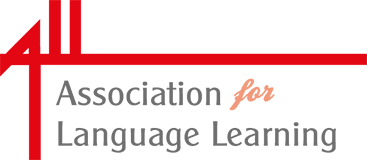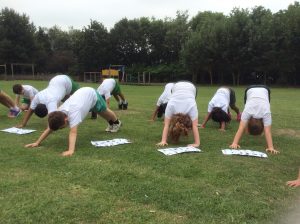Guest blog by Lisa Stevens, primary language teacher and ALL Council member.
There are several reasons why you might want to combine PE and languages.
Firstly, the primary curriculum is rich in content and there are so many interesting and exciting subjects that we need to teach; however, with that comes the challenge of fitting it all into the school day. The core subjects take precedence leaving restricted time for Foundation subjects. Blurring the edges of subjects and working across curriculum areas is one solution to the problem, and one that has traditionally been employed successfully in Primary schools.
Secondly, language is all around us, and speaking another language should not be confined to the classroom. By taking language into other areas of school life, be that the corridors, the playground or other lessons, it is given a real life context, ceasing to be a ‘subject’ and instead an integral and useful part of everyday life.
And thirdly, in schools where there is a specialist language teacher employed, combining PE and languages affords an opportunity for the class teacher to be involved in language with the class, whether that is by embedding previous learning, employing new vocabulary or by introducing a relevant cultural reference.
Let’s consider some practical ideas:
Some schools begin the morning with ‘Wake up, Shake up’ to get children active and moving. By choosing music in different languages, children are easily exposed to different rhythms and styles as well as becoming more familiar with the sounds of the language in an enjoyable and non-threatening way.
A couple of years ago, some Year 4 boys came back from holiday saying that they’d learned a Spanish song on holiday and could we sing it in class. Having listened to check the lyrics, an obsession with the ‘Chocolate’ song was born, and spread! It has a catchy tune, ready made dance moves that anyone can do, and very simple lyrics in English and Spanish. Without realising it, learners were exercising and familiarising themselves with the sound of Spanish (chocolate has four syllables not three in Spanish) and, possibly of equal importance, seeing language as a fun thing.
If you subscribe to 5 a day TV they have a Languages Channel with routines in French Spanish and Welsh. These videos (you can find a couple of examples on YouTube) are fun and include instructions in the target language. The instructions are not complicated and can easily be replicated by teacher or pupil after a few viewings.
You don’t have to conduct an entire PE lesson in French for it to make an impact. Simple warm up exercises can be really effective. Let’s think of the type of vocabulary that could be used for this.
Numbers is an easy one – call out a number in French and pupils have to get into a group with that number of people in it. Or play ‘puntos de contacto’ where you call a number and the pupils have to touch the ground with that number of body parts; this one is great fun as children rarely choose the obvious feet and hands, and try balancing on an elbow and a knee.
Colours can equally be used in this context. Pupils travel around and on command e.g. ¡Bleu! go to an object/area marked by that colour. I’ve played this with playground markings, and also with coloured cards on the walls. Equally you could try an elimination game using multiple coloured spots or hoops that children choose when the instruction is given. A colour is chosen at random and all those on that colour are out. And so on.
You can ask learners to travel ‘comme un élèphant’ or ‘comme une souris’ to integrate animal vocabulary, or include adverbs such as ‘schnell’, ‘langsam’ in German or ‘lentement’ and ‘rapidement’in French to guide movement.
And what about body parts? Combined with left and right, up and down, forward and back, it’s easy to make up mini warm up routines and give instructions. It could be modeled by the teacher and then pupils could take over, working together in small groups or leading the whole class warm up as confidence grows.
Equally, giving directions around to a partner to complete an assault course is a great way of reviewing prepositions of space such as under, over, through, between etc.
Take Ten is an excellent resource that could be used to support all the ideas we’ve looked at thus far. Conceived in Devon as a PE resource to support ten minutes activity a day, it was developed in French, then German and Spanish and offers simple physical games and activities starting in Foundation Stage and continuing up to Key Stage 2. The instructions are in English as well as the target language, and, especially important for the less confident teacher, there are audio files with the pronunciation of the instructions. Some activities can be used in the classroom such as Circles or Fairytale Fun (that links to Literacy and traditional tales) whilst others are more suited to a large space such as Four corners or True/ False.
Take Ten also takes traditional songs in French/Spanish/German and has active routines demonstrated on a DVD by children. Some will be familiar to learners such as Heads, shoulders, knees and toes, but others are particular to that language. For example, Savez vous plantez les choux? or Meunier tu dors? in French, Laurentia and Backe backe Kuchen in German or Debajo de un botón and Cielito lindo in Spanish.
This brings us onto another way in which language and PE go hand in hand – the introduction of a cultural perspective. For example, Ich geh’ mit meiner Laterne is a traditional song sung on 11 November on St Martins’ Day in Germany (and other European countries), and Talon punto on Take Ten en español is a traditional regional song and a dance that is danced with a partner.
The PE curriculum includes dance as well as gymnastics and games, and I’ve had great success exploring traditional Spanish dance with pupils as young as five and six, making up sequences using arm and feet movements from sevillanas. Take Ten en español has tutorials for flamenco (sevillanas) and salsa dances, but the internet and particularly YouTube is a rich source of inspiration for such activities. Why not explore the vocabulary of the dances too? Interjections such as ¡Olé! and ¡Baila! as well as technical vocabulary. Much ballet vocabulary comes from French – pas de deux, plié, chassé and so on!
While we’re talking about culture, playing games that are traditional in other countries is another way of complimenting and working with the languages as it also gives context to the words. Games such as the Spanish game, el pañuelo where children stand in two lines, numbered in the lines so that there is a 1, 2, 3 etc in both lines. The leader stands in the centre with a pañuelo or handkerchief and calls a number. The child from each line has to grab the handkerchief and get back behind their line without being caught. A great game for tactics! Equally, you could play it with a beanbag in the centre of a circle if you’re a little concerned about two children charging towards you!
Want to work on accuracy of throwing? Why not have a game of boule or petanque? A variation on the ‘ball games’ unit would be to learn the rules and tactics of handball, a popular sport in Spain but not so well known here.
What about trying some mindfulness or yoga? In preparation for Health Week at school, I collected some ideas together in a Pinterest board. A particularly successful activity was based around yoga poses named after animals and aspects of nature. Having rehearsed the movements in sequence, and allowed the children to make up their own sequences, we concluded with a story that included all the animal poses. Each time an animal was mentioned, we adopted that pose. So we had to listen out for specific Spanish vocabulary in a text, recall the matching pose, adopt it and at the same time, be listening out for the next one. Some of us even managed to transition between moves with something approaching fluidity. Year 5 really enjoyed it and said that it was one of their favourite lessons of the year. You could continue that activity back in the classroom with children writing their own yoga stories.
Parachute games are another way of bringing languages and PE together. Simple games might include manipulating the parachute by giving instructions such as tournez à droite/gauche or ‘plus rapide/lentement’, or assigning pupils a fruit and asking them to swap places under the parachute with another ‘fraise’, or (if the parachute is colourful) asking children who are holding ‘rouge’ to ‘changez des places’ You could up the linguistic content by telling a story including weather phrases and pupils could react by moving the parachute in response to the conditions eg hace sol could be holding it high in the sky, hace viento waving it gently, llueve, pulsing it like raindrops and so on. Using mucho/poco can add shades to this too. You could also balance a ball on the top of the parachute and manipulate it to a given person using only instructions in the target language – no English!
Arsenal football club have produced some excellent resources that link languages with football and healthy living including the vocabulary of football – why not be brave and have a go at ‘coaching’ or ‘commentating’ – both teacher and pupils!- next time you’re teaching a football unit. Likewise, take a look at the Language League Kick Off resources for French, German, Arabic and Spanish produced in conjunction with the Manchester Metropolitan University.
Sport and particularly important sporting events are a great motivation for learning so my last tip would be to make the most of things like the Olympics, the World Cup or Euros in football, Le Tour de France/Vuelta a España in cycling, to integrate language and sport. It could be as simple as naming teams at sports day in the target language or after participating countries in a tournament. You might talk statistics such as goals scored/miles covered/placings in French/Spanish/German, or be slightly more adventurous and conduct games in another language. Why not have a go at following simple instructions in another language, perhaps a pupil’s home language? It’s all good for using decoding strategies and language learning skills which are vital for real life interactions. A sporting context gives lots of opportunity for gesture and physical demonstration that support understanding.
I hope that this has given you some ideas and inspiration for linking PE and Language learning, and that you now feel more confident to have a go.
Lisa Stevens is a Primary languages educator and consultant who teaches at two contrasting Birmingham primary schools. She is a passionate advocate for creative primary language learning integrated into the curriculum and has consulted on various language, creativity and ICT projects including The Lingo Show, Pacca Alpaca app and BBC Primary MFL website. Lisa writes a blog called ¡Vámonos! (lisibo.com) and tweets as @lisibo when she's not running - and sometimes when she is!


